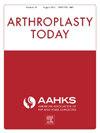全髋关节成形术髋臼组件倾角和反转角的自动网络工具测量。
IF 1.5
Q3 ORTHOPEDICS
引用次数: 0
摘要
背景:全髋关节置换术后假体周围脱位是一种严重的术后并发症。它通常与髋臼组件的定向欠佳有关,而髋臼外展和前内翻角度是从骨盆前向X光片上获得的。我们引入了一种新颖的自动化网络工具,以简化这一主观且冗长的人工测量过程,并将其与人工测量进行比较:一名获得认证的骨科外科医生使用该网络工具对97名接受单侧髋关节置换术的患者的前胸X光片进行了自动测量。手动和网络工具的测量结果包括外展角度和用Liaw方法计算的内翻角度。通过配对 t 检验和 Bland-Altman 分析比较了手动测量和网络工具测量之间的差异:结果:在外展角(43.29 ± 7.05 vs 43.00 + 6.22,P = .85)、内翻角(20.43 ± 7.62 vs 20.82 ± 7.37,P = .52)和AP片中髋臼杯周小轴与髋臼头总长度之比(0.42 ± 0.15 vs 0.44 ± 0.15,P = .18)方面,人工测量与网络工具测量的平均值差异无统计学意义。外展角、内翻角和横向椭圆短轴与髋臼杯总长度之比的平均差分别为-0.28、0.39和0.02。对所有 3 项测量结果进行的 Bland-Altman 分析表明,随机散射的系统偏差可以忽略不计:结论:使用新型网络工具获得的自动测量结果与人工获得的地面实况测量结果非常一致。网络工具有助于消除人工标注时出现的观察者之间的差异。该网络工具具有简化髋臼测量、提高测量准确性的潜力。本文章由计算机程序翻译,如有差异,请以英文原文为准。
Automated Web Tool Measurement of Total Hip Arthroplasty Acetabular Component Inclination and Anteversion Angles
Background
Periprosthetic hip dislocation after total hip arthroplasty is a devastating postoperative complication. It is often associated with suboptimal orientation of the acetabular component, characterized by the acetabular abduction and anteversion angles obtained from anteroposterior pelvic radiographs. We introduce a novel automated web tool to streamline the subjective and lengthy process of this manual measurement and compare it to manual human measurements.
Methods
One board-certified orthopaedic surgeon used the web tool to make automatic measurements of anteroposterior radiographs of 97 patients who underwent unilateral hip arthroplasty. Manual and web tool measurements included abduction angle and calculated anteversion angle by Liaw’s method. Differences between manual and web tool measurements were compared with a paired t-test and Bland-Altman analysis.
Results
There were no statistically significant differences between the average of manual measurements as compared to the web tool measurement in abduction angle (43.29 ± 7.05 vs 43.00 + 6.22, P = .85), anteversion angle (20.43 ± 7.62 vs 20.82 ± 7.37, P = .52), and ratio of the minor axis of the acetabular cup circumference in the AP radiograph to the total length of the acetabular head (0.42 ± 0.15 vs 0.44 ± 0.15, P = .18). The mean difference of average for abduction angle, anteversion angle, and ratio between the short axis of the transverse ellipse to the total length of the acetabular cup were −0.28, 0.39, and 0.02, respectively. Bland-Altman analysis for all 3 measurements displayed negligible systemic bias with random scattering.
Conclusions
Automated measurements obtained with a novel web tool are in strong agreement with the manually obtained ground truth measurements. The web tool helps to eliminate interobserver differences that arise with manual annotation. The web tool has the potential to streamline acetabular measurements with enhanced accuracy.
求助全文
通过发布文献求助,成功后即可免费获取论文全文。
去求助
来源期刊

Arthroplasty Today
Medicine-Surgery
CiteScore
2.90
自引率
0.00%
发文量
258
审稿时长
40 weeks
期刊介绍:
Arthroplasty Today is a companion journal to the Journal of Arthroplasty. The journal Arthroplasty Today brings together the clinical and scientific foundations for joint replacement of the hip and knee in an open-access, online format. Arthroplasty Today solicits manuscripts of the highest quality from all areas of scientific endeavor that relate to joint replacement or the treatment of its complications, including those dealing with patient outcomes, economic and policy issues, prosthetic design, biomechanics, biomaterials, and biologic response to arthroplasty. The journal focuses on case reports. It is the purpose of Arthroplasty Today to present material to practicing orthopaedic surgeons that will keep them abreast of developments in the field, prove useful in the care of patients, and aid in understanding the scientific foundation of this subspecialty area of joint replacement. The international members of the Editorial Board provide a worldwide perspective for the journal''s area of interest. Their participation ensures that each issue of Arthroplasty Today provides the reader with timely, peer-reviewed articles of the highest quality.
 求助内容:
求助内容: 应助结果提醒方式:
应助结果提醒方式:


